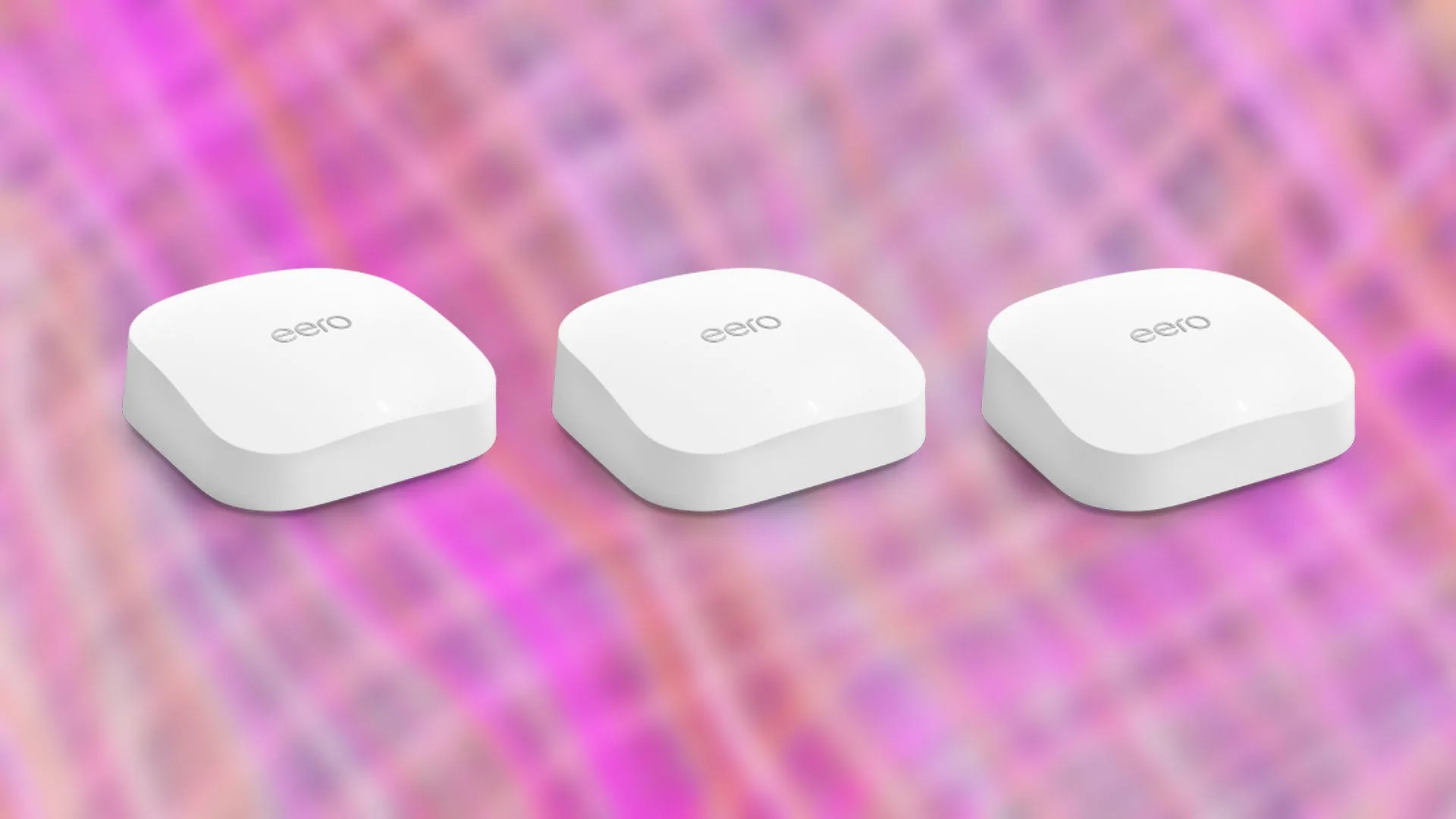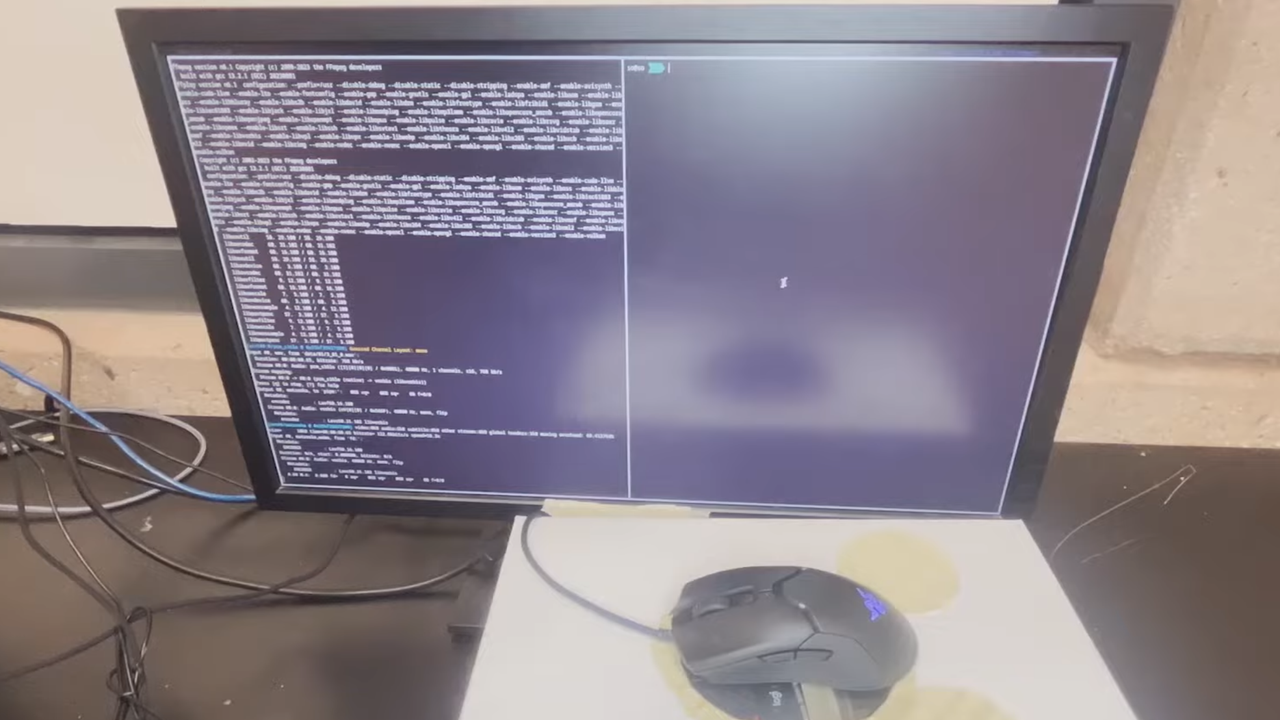The Best Mesh Routers to Buy in 2024
Even the best wireless routers can struggle to provide a reliable connection if you have a large space or lots of walls and obstacles. That’s where a mesh system comes in clutch, delivering all the coverage needed to ensure the best laptops and best gaming PCs always have a strong connection. Our favorite mesh router is the eero Pro 6E for its balance of price and performance. But we’ve found alternatives, from budget-friendly to speedy, feature-rich options, and there may be even more great routers coming out of CES 2024.
TL;DR – Here are the Best Mesh Routers:
eero Pro 6EAsus ZenWiFi XD5TP-Link Deco XE75NETGEAR Orbi Quad-Band WiFi 6E Mesh System (RBKE963)Linksys Atlas Max 6ETP-Link Deco X55Nighthawk Mesh WiFi 6 System (MK83)Google Nest WifiAsus ZenWiFi ET8
In some cases, one of the best Wi-Fi range extenders may be an easy alternative for a few dead zones. But if your router is outdated or you’re still not getting a reliable connection throughout your home, grabbing one of the best mesh routers is the way to go. These systems consist of a main router and separate modules to spread around your space, creating an even, steady network to connect all your devices.
Finding the best mesh router for your home and needs can be complicated, so we’ve done the leg work, bringing you nine great options – and click here to find them in the UK.
Best Mesh Routers
1. eero Pro 6E
Best Mesh Router
Wi-Fi Technology: Tri-Band IEEE 802.11ax (Wi-Fi 6E) | Frequency: 2.4GHz, 5GHz, 6GHz | Features: Bluetooth LE 5.0, Zigbee, Thread, VPN passthrough, WPA3
The eero Pro 6E mesh router system is perfect for getting your whole home up to speed for streaming and gaming alike. Its compact units fly under the radar thanks to an unobtrusive, simple design. But, don’t worry, these little devices mean business when it comes to providing extensive coverage and fast speeds. Pretty much anyone can set up this system through the eero app. And, once it’s up and running, you can enjoy some awesome features like Zigbee and Thread compatibility for use with your smart home devices and advanced online protection with encryption tools and security protocols.
With the eero Pro 6E mesh system, you’re getting nodes that support tri-band Wi-Fi. There is a 2.4GHz band, a 5GHz band, and even a 6Ghz band to use with Wi-Fi 6E devices. And, you’re in for tons of bandwidth to support all the connected electronics in your home – we’re talking 4,000 square feet of coverage to over 100 devices. Plus, each node in the system will maintain high-speed, stable communications between themselves. Since Wi-Fi 6E is also supported, it will further speed up your connections. In total, you can get 2.3 Gbps network speeds when using wired and wireless client devices. Each unit has dual Ethernet ports on the back, too, in case you decide you want to wire anything up or run a wired backhaul between nodes.
2. Asus ZenWiFi XD5
Best Budget Mesh Router
Wi-Fi Technology: Dual-Band IEEE 802.11ax (Wi-Fi 6) | Frequency: 2.4GHz, 5GHz | Signal Rate: 574 (2.4GHz), 2,402GHz (5GHz) | Features: MU-MIMO, QoS, Parental controls, WPA3
Many mesh setups cost a decent chunk of change, but if you just want decent speeds and a system that covers some extra distance and devices, the Asus ZenWiFi XD5 is for you. With it, you get a straightforward, easy-to-install system, and it gets bonus points for its sleek, compact design and highly attainable price point – three nodes for under $300. You can even do things like prioritize devices, turn on parental controls, and create guest networks.
With the Asus ZenWiFi XD5 three-pack, there is enough bandwidth to cover up to 5,000 square feet. You get Wi-Fi 6 support, so you can hit speeds up to 2,402Mbps on the 5GHz band for needier gadgets like TVs and computers, while the 2.4GHz band is ideal for most other devices. Each node is even quipped with Ethernet ports for devices that may benefit from a slightly more reliable wired connection.
3. TP-Link Deco XE75
Best Mid-Range Mesh Router
Wi-Fi Technology: Tri-Band IEEE 802.11ax (Wi-Fi 6E) | Frequency: 2.4GHz, 5GHz, 6GHz | Signal Rate: 2402 Mbps (6GHz), 2402 Mbps (5GHz), 574 Mbps(2.4GHz) | Features: MU-MIMO, OFDMA,QoS, beamforming, WPA3
You don’t need to blow your budget completely out of the water to get your home set up with a powerful mesh network. Often, the biggest barrier is the high cost of multiple nodes, but the TP-Link Deco XE75 makes it much more attainable. You can grab a two-pack for under $300. And, if you’re worried that the lower cost means lost capabilities, don’t be, this system still offers Wi-Fi 6E, high speeds, loads of coverage, and powerful features.
Once you spread out the TP-Link Deco XE75 units around your home, you get broad coverage that prevents Wi-Fi dead spots. This system offers up tri-band Wifi with the new 6Hz band allowing you to use it as a powerful dedicated backhaul between nodes for an extra stable connection or to connect your Wi-Fi 6E compatible devices. It’s also packing OFDMA and MU-MIMO technology, so communication with your computers, phones, and smart home devices is faster and more dependable, and it allows for better communication between each node in the mesh network. You can even assign your favorite devices to have the fastest connection in your home. Speaking of home, most people should be good with just the two nodes, as they cover 5,500 square feet of space.
4. NETGEAR Orbi Quad-Band WiFi 6E Mesh System (RBKE963)
Best High-End Mesh Router
Wi-Fi Technology: Quad-Band 802.11axe (Wi-Fi 6E) | Frequency: 2.4GHz, 2 x 5GHz, 6GHz | Signal Rate: 4,800Mbps (6GHz), 2,400Mbps (5GHz), 1,200Mbps (2.4GHz) | Features: Beamforming, MU-MIMO, WPA2, WPA3, QoS, OFDMA, QAM, 160MHz channel bandwidth
Once you get past the price tag, you’ll find that the NETGEAR Orbi Quad-Band WiFi 6E Mesh System is the speediest and most feature-rich option out there that may just be worth the splurge. This system is one of the best gaming router options and offers four bands thanks to the support of WiFi6E, all of which tote insanely capable data rates, including two 5GHz bands with 2,400Mbps speeds—one dedicated to backhaul between nodes—and the 6GHz band that gets 4,800Mbps. Both the router and two satellites each have 12 antennas aiding their performance and four Ethernet ports to wire up stationary devices. If you prefer a wired backhaul configuration between nodes rather than wireless, you can use the 2.5Gbps LAN port.
This sleek system is super easy to set up, as you just download the Orbi app, and it’ll walk you through everything with step-by-step instructions. There’s even the added convenience of only needing one Wi-Fi network name. Orbi works great for most homes, covering 9,000 square feet, so unless you live in a mega-mansion, you’re good. You can always purchase more units to cover more ground, too. Using the app, you also can adjust parental controls, configure security settings, create guest networks, monitor traffic, and plenty more. Overall, if money is no object when it comes to your internet, the NETGEAR Orbi Quad-Band WiFi 6E Mesh System is the way to go.
5. Linksys Atlas Max 6E
Best Wi-Fi 6E Mesh Router
Wi-Fi Technology: Tri-Band IEEE 802.11ax (Wi-Fi 6E) | Frequency: 2.4GHz, 5GHz, 6GHz | Signal Rate: 1,147Mbps (2.4GHz), 2,402Mbps (5GHz), 4,804Mbps (6GHz) | Features: 4 x 4 MU-MIMO, WPA-3 encryption, USB 3.0 port
The Linksys Atlas Max 6E is built for some of the most demanding home Wi-Fi setups, and its speeds won’t leave you hanging. With this high-end mesh system, you get Wi-Fi 6E, which means access to the 6GHz band connection. This additional frequency is perfect for pro-gaming, video conferencing, and HD streaming. And, it can handle doing all of this simultaneously. It easily communicates with your client devices and transmits data between nodes even under the heaviest of loads. How heavy are we talking? Well, the 2.4GHz band alone can handle over 1,000Mbps, and with all three bands combined, each node offers up a signal rate of 8,400Mbps. Now, that’s a lot of speed.
Showing its commitment to performance, the Linksys Atlas Max 6E includes 4×4 MU-MIMO on not just the 6GHz band but also on the 5GHz and 2.4GHz bands. That not only makes the connections to devices stronger and more reliable, but it also helps with communication between nodes. And, since this kit is built for speed, you’ll even find a 5Gb WAN port on each unit to ensure you’ve got a ton of bandwidth for any device you want to connect to the internet. Once you get past the hefty price tag, you’ll find this is one of the most capable mesh routers out there.
6. TP-Link Deco X55
Best Secure Mesh Router
Wi-Fi Technology: Dual-Band AX3000 IEEE 802.11ax (Wi-Fi 6) | Frequency: 2.4GHz, 5GHz | Signal Rate: 2,402Mbps (5GHz), 574Mbps (2.4GHz) | Features: MU-MIMO, OFDMA, QoS, beamforming, WPA3
You want your Wi-Fi to go fast, but you also want to be sure your connection is secure, and the TP-Link Deco X55 ensures your safety while surfing. This mesh system uses the latest WPA3-Personal protocol, making it much more difficult to break into your network by guessing passwords. That’s just the start, as TP-Link includes a host of other security features through its subscription-based HomeShield kit, which can scan for malicious content, shield against DDoS attacks, protect IoT devices, and provide access to a suite of parental controls.
On the speed side of the fence, the Deco X55 system runs fast dual-band Wi-Fi 6 with a 5GHz network offering 2,402Mbps of throughput, ideal for gaming or streaming. There are also three ethernet ports available on each node for a wired connection to devices or backhaul to increase speeds. Meanwhile, MU-MIMO, OFDMA, and beamforming should keep the Wi-Fi on your phone, computer, and other devices stable and speedy.
7. Nighthawk Mesh WiFi 6 System (MK83)
Best Wi-Fi 6 Mesh Router
Wi-Fi Technology: Tri-Band AX1800 IEEE 802.11ax (Wi-Fi 6) | Frequency: 2.4GHz, 5GHz | Signal Rate: 1,800 Mbps (5GHz), 1,200Mbps (5GHz), 600Mbps (2.4GHz) | Features: QoS, OFDMA, Ethernet backhaul, WPA-3
The Netgear Nighthawk Mesh WiFi 6 MK83 offers up tri-band Wi-Fi, which includes an additional 5GHz signal. Between the three bands, the system is able to max out at 3,600Mbps of bandwidth. This helps keep speeds between your devices and the nodes uncongested. You’ll also get the option to set up your network with a wired backhaul for more consistent performance. Plus, you can plug in computers, gaming consoles, and other devices to the LAN ports for a super strong and stable wired connection. And, keep in mind that this is a Wi-Fi 6 system, so client devices that use Wi-Fi 6 can take full advantage of the speeds available.
For all its functionality, this Nighthawk system is actually surprisingly affordable, coming in at just $400. With it, you’re getting a three-unit setup that includes a base station and two satellites. This allows for up 6,750 square feet of coverage on 40 devices, but you can always add more satellites to amp up the coverage. It’s also easy to set up and will work great in conjunction with your current ISP.
8. Google Nest Wifi
Best Wi-Fi Mesh Router for Smart Homes
Wi-Fi Technology: Dual-Band IEEE 802.11s | Frequency: 2.4GHz, 5GHz | Features: 4×4 MU-MIMO, Bluetooth LE, WPA-3 encryption, Transmit beamforming, Google Assistant built-in, 40mm speaker driver
Google’s Nest Wifi mesh network system is ready to make your smart home a little bit smarter. Aside from offering the benefits of a powerful mesh network, each Nest Wifi point also doubles as a Google Assistant smart speaker. That means you’ll not only be expanding your network coverage as you add Nest devices, but you’ll also be expanding control over your smart home. And, with the Google Home app, it’s easy to get set up and online quick as well as monitor activity and prioritize devices on the network.
This system is designed with smart homes in mind, and it is aiming to support the 802.15.4 Thread on the 2.4GHz band for future smart home connectivity. Plus, the 5GHz band is perfect for data-heavy tasks like 4K streaming or online gaming. Each point in the system can even support up to 100 connected devices. Google Nest Wifi also works seamlessly with Google Wifi, so you can add units from either to increase range.
9. Asus ZenWiFi ET8
Fastest Mesh Router
See it on Amazon (used)
Wi-Fi Technology: Tri-Band IEEE 802.11ax (Wi-Fi 6E) | Frequency: 2.4GHz, 5GHz, 6GHz | Signal Rate: 574Mbps (2.4GHz), 1201Mbps (5GHz), 4804Mbps (6GHz) | Features: MU-MIMO, beamforming, OFDMA, up to 160MHz bandwidth, 2.5Gb WAN, USB 3.1 Gen 1, Alexa, IFTTT, Adaptive QoS, WAN Aggregation
A lot of mesh Wi-Fi setups may be focused on coverage, but the Asus ZenWiFi ET8 system is focused on speed, and it delivers. This mesh system combines identical base stations, so you can use nodes interchangeably. And, the system doesn’t settle for just Wi-Fi 6 but actually steps it up to Wi-Fi 6E. That upgrade brings you a 6GHz band on top of the 2.4GHz and 5GHz bands that support more of your legacy devices.
With Wi-Fi 6E, you’re looking at some extreme bandwidth. The 5GHz band is capable of 1,201 Mbps speeds, and the 6GHz band can hit 4,804Mbps. The link between the nodes in the mesh system stays strong thanks to these available speeds, and you’ll experience a consistent, reliable connection on all of your devices. Topping it off, the system includes 2.5GbE ports for a WAN connection for a speedy wired internet connection. And, there are USB ports onboard, so you can easily set up fast network storage.
Mesh Wi-Fi System FAQs
Is Mesh Wi-Fi Worth it for Gaming?
That’s up for debate. Sure, mesh routers do a great job at eliminating dead zones and connecting to tons of devices throughout your home, thanks to multiple nodes. But in gaming, latency comes into play, especially in competitive multiplayer games. On a mesh network, latency and speed can be inconsistent due to multiple nodes, network congestion, and different data routes between the nodes and the router. Mesh routers also often lack the more advanced features of gaming routers, like adaptive QoS, a powerful RAM and CPU, and multiple gigabit ethernet ports to hook up your gaming systems for a wired connection. That makes dedicated gaming routers a better option.
More recently released mesh routers, like the NETGEAR Orbi Quad-Band WiFi 6E Mesh System or the Linksys Atlas Max 6E, deliver on some of these advanced features, but the price is astronomical when you add in the nodes. However, more budget-friendly systems should suffice if you’re not doing a ton of competitive gaming or your network isn’t super congested with devices.
What are the Disadvantages of Mesh Wi-Fi?
Mesh Wi-Fi has its perks, including better whole-home coverage, easy setup and network management, and improved security. Though, there are some negatives, which we discuss below.
Expensive: Mesh Systems don’t come cheap, with a router and one or two nodes setting you back at least $150 to $200, and that’s the budget option. If you want additional nodes for better coverage, each one will cost you $50 or more. More powerful systems with the Wi-Fi 6E and advanced features jump in price quickly, with some costing over $1,000 for just a router and one node.
Latency: As mentioned above, mesh Wi-Fi often leads to latency issues due to various factors, like communication between nodes or network congestion. Low latency is crucial in online gaming, where a couple of milliseconds of lag could lead to you getting taken out by your opponents. The best way to eliminate lag is by using a wired ethernet connection, or even a wired ethernet backhaul between nodes could help.
Extra gear: You want to place multiple nodes around your home to take full advantage of the system’s abilities, but that means you need to find space for them. Luckily, most of these satellites are small and should fit in tight spaces, though you also want to be sure you put them in an ideal spot to receive the best signal, which could make them an eyesore. If you’re looking to add an ethernet backhaul between nodes, that adds more wires into the mix, increasing the clutter in your home.
Pointless coverage: One of the main reasons to get a mesh system is to increase the Wi-Fi range in your space. But if you’re living in a smaller home or apartment with no dead zones, you probably don’t need the extra square footage of coverage. You might be better off upgrading to a new traditional router and putting it in a central location.
What to Look for in a Mesh Router
The first thing you should consider when getting a Wi-Fi Mesh system is whether you need one in the first place. Wi-Fi mesh systems are mostly useful for large houses, apartments, or just homes with a lot of walls—all situations where a single wireless router would have trouble providing a strong signal everywhere.
If you live in a studio or one-bedroom apartment, you’re going to be better off with just a single router and the same goes for smaller single-floor houses. However, if you start encountering odd Wi-Fi dead spots in your home this is exactly what Wi-Fi Extenders and Wi-Fi Mesh systems are designed to combat. Wi-Fi Extenders are a good solution if you already own a decent router and just need to strengthen your wireless signal in part of your living space, but most require you to manually switch networks. Wi-Fi Mesh systems on the other hand automatically switch you between the base unit and satellites to ensure you’re getting the best signal at all times.
How to make the most of your Wi-Fi Mesh System
Mesh Wi-Fi is an impressive technology, but each unit in the system is still a wireless access point at the end of the day. That means you need to consider many of the same home network best practices with each node as you would with a standard wireless router.
To ensure each node is able to perform its very best, you should carefully consider the positioning. You’ll want to keep nodes out in the open (don’t stuff them in closet), ideally high up, and away from any barriers that can block the signal, especially metal barriers.
Some systems may automatically try to optimize the network, but if you live in an area with a dense population, this can be difficult. If you really want to get the most out of your network, you should try to see how many networks you can already detect in your home, and consider setting up your home network on different channels than the ones you see all your neighbors using.
Another smart step you can take to get the most out of your Wi-Fi is actually to use Ethernet connections wherever you can. If you have a smart TV right next to a node, you should plug it directly into the node. This will give the TV a more stable connection, will cut down on the signal clutter in the area, and will improve the wireless connections for other devices that don’t have a wired connection as a backup.
You also need to treat your mesh Wi-Fi like any other wireless network and give strong consideration to its security. You’ll want to give it a strong password and disable unnecessary extra features like WPS, which could let people get around your password with the press of a button. You might also consider whether you want to create an additional guest network you can let visitors access that is walled away from the main network and can have more frequent password changes.
Where to Get the Best Mesh Wi-Fi in the UK
Whitson Gordon is a writer, gamer, and tech nerd who has been building PCs for 10 years. He eats potato chips with chopsticks so he doesn’t get grease on his mechanical keyboard.











Post Comment